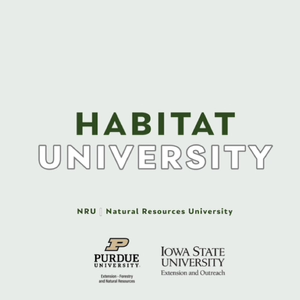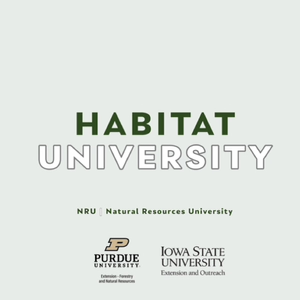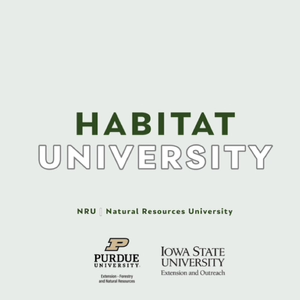
Habitat University
Jarred Brooke & Adam Janke
All episodes
Best episodes
Seasons
Top 10 Habitat University Episodes
Goodpods has curated a list of the 10 best Habitat University episodes, ranked by the number of listens and likes each episode have garnered from our listeners. If you are listening to Habitat University for the first time, there's no better place to start than with one of these standout episodes. If you are a fan of the show, vote for your favorite Habitat University episode by adding your comments to the episode page.

Holiday habitat wishlist | Ep 14
Habitat University
12/07/21 • 33 min
You can find Adam and Jarred’s wishlist below along with some helpful links.
Adam’s WIshlist
- Native Plants - https://www.nwf.org/Garden-for-Wildlife/about/native-plants
- Field Guide (Adam’s Favorite) - https://www.littlebrown.com/titles/lawrence-newcomb/newcombs-wildflower-guide/9780316604420/
- Woodworking for wildlife - https://naturalresources.extension.iastate.edu/wildlife/woodworking-wildlife
- Cellular Trail Camera - https://www.trailcampro.com/collections/cellular-trail-cameras
- Good Books (Adam’s recommendation) - https://milkweed.org/book/braiding-sweetgrass
Jarred’s Wishlist
- Drone or UAV - https://extension.purdue.edu/uav/natural-resources/
- Invasive control tools (Backpack sprayer or pulling tool) - https://www.entm.purdue.edu/iisc/pdf/ABH_Tool_Info.pdf
- Gift certificate or registering for an in-person or online wildlife/habitat management course - https://www.deerassociation.com/steward/
- Chainsaw or Prescribed Fire PPE - https://secure.caes.uga.edu/extension/publications/files/pdf/C%201148_1.PDF https://research.cnr.ncsu.edu/blogs/southeast-fire-update/2019/09/09/ppe-for-landowners-practical-clothing-options/
- Drip torch - https://www.forestry-suppliers.com/product_pages/products.php?mi=15801&itemnum=85022
Disclaimer
Reference to any specific commercial product, process, or service, or the use of any trade, firm, or corporation name is for general informational purposes only and does not constitute an endorsement, recommendation, or certification of any kind by Purdue Extension. Persons using such products assume responsibility for their use in accordance with current directions of the manufacturer.

From Litter to Glitter: Restoring oak woodlands and savannas with fire and thinning (Part 2/2) | #28
Habitat University
05/08/24 • 62 min
What distinguishes a forest, woodland, and savanna? How does wildlife and plant diversity differ between them? How do we restore woodlands and savannas? Join Jarred as he talks with Dr. Andy Vander Yacht about his research into restoring oak woodlands and savannas and the wildlife that thrive within in.
In part 2, we discuss how birds and bats responded to restoration treatments (thinning and fire), and how Andy’s research can inform oak woodland restoration on public and private land.
Give us some feedback or potential topics you would like to here by filling out our listener survey:
https://purdue.ca1.qualtrics.com/jfe/form/SV_5oteinFuEzFCDmm
Research & Resources discussed in the episode
Dr. Andy Vander Yacht - https://www.esf.edu/faculty/vander_yacht/index.php
Ecology and Management of Oak Woodlands and Savannahs - https://utia.tennessee.edu/publications/wp-content/uploads/sites/269/2023/10/PB1812.pdf
Bat response to prescribed fire and overstory thinning in hardwood forest on the Cumberland Plateau, Tennessee - https://www.sciencedirect.com/science/article/pii/S0378112715005435
Avian occupancy response to oak woodland and savanna restoration - https://wildlife.onlinelibrary.wiley.com/doi/full/10.1002/jwmg.21097

From Litter to Glitter: Restoring oak woodlands and savannas with fire and thinning (Part 1/2) | #27
Habitat University
05/01/24 • 58 min
What distinguishes a forest, woodland, and savanna? How does wildlife and plant diversity differ between them? How do we restore woodlands and savannas? Join Jarred as he talks with Dr. Andy Vander Yacht about his research into restoring oak woodlands and savannas and the wildlife that thrive within in.
This is a two-part series. In part 1, we discuss the historical context of forests, woodlands, and savannas in the eastern US, and Andy’s research into how fire and thinning influence plant composition and diversity.
Give us some feedback or potential topics you would like to here by filling out our listener survey:
https://purdue.ca1.qualtrics.com/jfe/form/SV_5oteinFuEzFCDmm
Research & Resources discussed in the episode
Dr. Andy Vander Yacht - https://www.esf.edu/faculty/vander_yacht/index.php
Vegetation response to canopy disturbance and season of burn during oak woodland and savanna restoration in Tennessee - https://www.sciencedirect.com/science/article/pii/S0378112716311513
Litter to glitter: promoting herbaceous groundcover and diversity in mid-southern USA oak forests using canopy disturbance and fire - https://link.springer.com/article/10.1186/s42408-020-00072-2
Reversing Mesophication Effects on Understory Woody Vegetation in Mid-Southern Oak Forests - https://academic.oup.com/forestscience/article/65/3/289/5232699
Restoration of oak woodlands and savannas in Tennessee using canopy-disturbance, fire-season, and herbicides - https://www.sciencedirect.com/science/article/pii/S0378112717307776
Fuel dynamics during oak woodland and savanna restoration in the Mid-South USA - https://www.publish.csiro.au/wf/wf18048
Webinar: Litter to glitter: releasing the herbaceous groundlayer potential stored in oak forest floors - https://vimeo.com/493748345

Forest management for birds: an introduction to the series | #26
Habitat University
04/03/24 • 41 min
Ahead of a forthcoming mini-series on forest management for birds, Adam and Jarred discuss a paper reviewing the state of the science examining bird responses to forest management in the eastern U.S. The paper published last year by Michael Skresh and colleagues presents a compelling case for the importance of managed disturbances in eastern forests to benefit birds of conservation concern. Jarred also foreshadows some conversations he has planned in the coming episodes.
Give us some feedback or potential topics you would like to here by filling out our listener survey:
https://purdue.ca1.qualtrics.com/jfe/form/SV_5oteinFuEzFCDmm
Research & Resources discussed in the episode
Here's the paper we discussed: Akresh, Michael E., David I. King, Savannah L. McInvale, Jeffery L. Larkin, and Anthony W. D'Amato. 2023. “ Effects of Forest Management on the Conservation of Bird Communities in Eastern North America: A Meta-Analysis.” Ecosphere 14(1): e4315. https://doi.org/10.1002/ecs2.4315
Here’s a paper Adam’s written about forest management for birds: https://store.extension.iastate.edu/Product/15963 h
Here’s the episode we mentioned with Marcus Lashley and fire disturbance regimes: https://habitatuniversity.libsyn.com/episode-03-aldos-tools-getting-creative-with-prescribed-fire

Conserving Wildlife in Ag. Landscapes: Creating win-win solutions for wildlife and farmers | #25
Habitat University
02/28/24 • 83 min
In this episode we talk with Dr. Mark McConnell, Assistant Professor of Upland Birds at Mississippi State, about wildlife conservation in agricultural landscapes and his research into creating win-win solutions for wildlife and agricultural producers. We cover a variety of topics in this episode from reacting to Adam’s new mustache, Mark’s use of memes to help wildlife student engage with farmers, and using precision conservation to delivery economically targeted conservation.
Themes in the episode: meeting farmer where they are, building your conservation team, economics and Precision Agricultural/Conservation. Targeted Conservation Delivery, Economically Targeted Conservation, Wildlife-Friendly Farming
Give us some feedback or potential topics you would like to here by filling out our listener survey:
https://purdue.ca1.qualtrics.com/jfe/form/SV_5oteinFuEzFCDmm
Research & Resources discussed in the episode
Research on who farmers trust when making decisions about agricultural practices - https://www.extension.purdue.edu/extmedia/FNR/fnr-488-w.pdf
Personal outreach to landowners is vital to conservation program success (article about Lutter et al 2018 paper). https://www.sciencedaily.com/releases/2018/04/180405093305.htmBridging the gap between conservation delivery and economics with precision agriculture (McConnell 2021) - https://wildlife.onlinelibrary.wiley.com/doi/full/10.1002/wsb.995
Economically targeting conservation practices to optimize conservation and net revenue using precision agriculture tools (Meng et al. 2022) - https://link.springer.com/article/10.1007/s11119-022-09890-7
Farming and the fate of nature (Green et al. 2005) - https://www.science.org/doi/10.1126/science.1106049
Wildlife-friendly farming benefits rare birds, bees and plants (Pywell et al. 2012) - https://pubmed.ncbi.nlm.nih.gov/22675140/
Crop Advisors as Conservation Intermediaries (Eanes et al. 2019) - https://www.sciencedirect.com/science/article/pii/S0264837718310238
Creating Environmentally Resilient Agriculture Landscapes Using Precision Agriculture Technology: An Economic Perspective (McConnell 2019) - https://pubs.acs.org/doi/abs/10.1021/bk-2019-1334.ch007
CRP Menu Tool - https://crpmenu.gri.msstate.edu/

Private lands wrapped! | #24
Habitat University
01/17/24 • 60 min
In the final episode of our second season, Jarred and Adam review the conversations we’ve had on the theme of private lands habitat conservation, discuss some things “left on the bone,” and share with the listeners where Habitat University is heading in the new year! Be sure to check out the previous episodes in the podcast, including those from Season 2 discussed in this episode, and Season 1 if you haven’t already! And as always please help us improve the podcast by taking this Habitat University Listener Feedback Survey: https://purdue.ca1.qualtrics.com/jfe/form/SV_5oteinFuEzFCDmm
Resources mentioned in the episode:
Bird friend coffee: https://nationalzoo.si.edu/migratory-birds/bird-friendly
Bird friendly beef: https://www.audubon.org/conservation/ranching
Learn more about the Land sparing and land sharing debate with this article: https://e360.yale.edu/features/sparing-vs-sharing-the-great-debate-over-how-to-protect-nature
For a much more thorough treatment of the history of Native peoples’ relationships to much of what we today know as private land, check out the exceptional book: An Indigenous Peoples' History of the United States by Roxanne Dunbar-Ortiz

Whitetails on Private Lands with Matt Ross from NDA | Ep 23
Habitat University
10/10/23 • 87 min
We are joined this week by Matt Ross from the National Deer Association to chat about the importance of private lands and private land management for America’s favorite game species, the white-tailed deer. We discuss how whitetails can be a catalyst for private lands habitat management and all the work NDA does to assist private landowners.
Resources discussed:
National Deer Association – https://deerassociation.com/
2023 Deer Report - https://deerassociation.com/2023-deer-report/
Deer Steward Program - https://deerassociation.com/steward/
Land Certification Program - https://deerassociation.com/land-certification/
Cooperative Program - https://deerassociation.com/coop/
Golden, K. E., M. N. Peterson, C. S. DePerno, R. E. Bardon, and C. E. Moorman. 2012. Factors shaping private landowner engagement in wildlife management. Wildlife Society Bulletin 37:94–100. https://wildlife.onlinelibrary.wiley.com/doi/full/10.1002/wsb.235
Macaulay, L. 2016. The role of wildlife-associated recreation in private land use and conservation: Providing the missing baseline. Land Use Policy 58:218–233. https://www.sciencedirect.com/science/article/pii/S0264837716306159
Mitterling, A. M., B. A. Rudolph, and D. B. Kramer. 2021. The Influence of Private Land Deer Management Cooperatives on Harvest Outcomes and Hunter Satisfaction. Wildlife Society Bulletin 45:456–464. https://wildlife.onlinelibrary.wiley.com/doi/full/10.1002/wsb.1209?af=R
Pruitt, H. P., B. B. Boley, G. K. D’Angelo, and M. D. McConnell. 2022. Deer management cooperative members’ likelihood of engaging in conservation initiatives: an importance-likelihood analysis. Human Dimensions of Wildlife 0:1–20. https://www.tandfonline.com/doi/full/10.1080/10871209.2022.2077483

Getting kids engaged in habitat management through WHEP | Bonus
Habitat University
05/25/23 • 38 min
In this episode, Jarred and Adam explain the Wildlife Habitat Education Program, which engages kids from throughout the country in wildlife habitat management through 4-H and FFA. Adam and Jarred first discuss the structure of the program and how it’s implemented in states across the country, and then they explore the national competition, including featuring voices of competitors from the 2022 National Competition in Kentucky.
If you’re interested in starting a WHEP club in your community, you should reach out to your local or state 4-H or FFA leaders. Learn more about the program and how to get involved at the link below.
Help us improve the podcast by taking this Habitat University Listener Feedback Survey: https://purdue.ca1.qualtrics.com/jfe/form/SV_5oteinFuEzFCDmm
Resources from the episode:
Learn more about WHEP at: https://www.whep.org/

Farm Bill Biologists and Beyond: Pheasants & Quail Forever’s Approach to Private Land Conservation | Ep 22
Habitat University
04/12/23 • 61 min
When it comes to getting boots on the ground for private lands conservation, Pheasants Forever & Quail Forever is a leader. This episode we are joined by Quail Forever Tennessee State Coordinator, Brittney Viers, to discuss all the work PF & QF does for wildlife on private lands. From Farm Bill Biologists to Precision Ag & Conservation Specialists, tune in to learn about the wide-ranging roles of PFQF employees, and how they work to create and enhance habitat on private lands.
Help us improve the podcast by taking this Habitat University Listener Feedback Survey: https://purdue.ca1.qualtrics.com/jfe/form/SV_5oteinFuEzFCDmm
Resources from the episode:
Find your local Pheasants Forever or Quail Forever Biologist: https://quailforever.org/Habitat/findBiologist.aspx
Contact a Precision Ag & Conservation Specialist: https://www.pheasantsforever.org/Conservation/Precision-Agriculture/Contact.aspx

Aldo's tools: Getting creative with prescribed fire, ft. Dr. Marcus Lashley | Ep 04
Habitat University
01/26/21 • 58 min
How can prescribed fire be used creatively to create and enhance habitat for wildlife? Dr. Marcus Lashley, Assistant Professor and Extension Wildlife Specialist at University of Florida and host of Fire University, joins the podcast to tackle this question, and we take a deep dive into prescribed fire as a habitat management tool.
>
Dr. Marcus Lashley - @DrDisturbance - @ufdeerlab
Resources discussed in the episode
Fire University Episode 3 – Where to get information, experience, and collaborators to meet prescribed burning objectives - https://fireuniversity.libsyn.com/episode-03-where-to-get-information-experience-and-collaborators-to-meet-prescribed-burning-objectives
Fire University Episode 4 – Patch-Burn-Grazing as a strategy to manage grassland communities - https://fireuniversity.libsyn.com/episode-04-patch-burn-grazing-as-a-strategy-to-manage-grassland-communities
Natural Resources University - https://naturalresourcesuniversity.libsyn.com/
Southern Fire Exchange - https://southernfireexchange.org/
Coalition of Prescribed Fire Council - http://www.prescribedfire.net/
Prescribed Burn Associations - https://research.cnr.ncsu.edu/blogs/southeast-fire-update/prescribed-burn-associations/
Enroll now in our free wildland fire course. Available to all!
This podcast is supported by listener donations - thank you for being a part of this effort.
Show more best episodes

Show more best episodes
FAQ
How many episodes does Habitat University have?
Habitat University currently has 38 episodes available.
What topics does Habitat University cover?
The podcast is about Outdoor, Conservation, Nature, Wildlife, Podcasts and Science.
What is the most popular episode on Habitat University?
The episode title 'From Litter to Glitter: Restoring oak woodlands and savannas with fire and thinning (Part 1/2) | #27' is the most popular.
What is the average episode length on Habitat University?
The average episode length on Habitat University is 57 minutes.
How often are episodes of Habitat University released?
Episodes of Habitat University are typically released every 28 days.
When was the first episode of Habitat University?
The first episode of Habitat University was released on Dec 1, 2020.
Show more FAQ

Show more FAQ